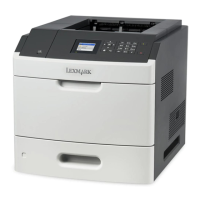PCL 5 emulation: Lexmark
37
ESC
%0B
COLexmark Enhanced GL/2;
ESC
%0A
Command examples:
Australian Post bar code with FCC=11, encoding table = N, data = 12345678:
ESC
&x8W[00 14 32 18 82 B9 0B 01]
ESC
&y8W12345678
Two-dimensional PDF417 with ECC = 2, data = 12345678:
ESC
&x3W[00 01 02]
ESC
&y8W12345678
The general strategy for assigning new Lexmark symbology IDs and defining new Lexmark bar code
descriptors is defined in the following table:
For new one-dimensional bar codes, the Lexmark bar code descriptors all have the same initial 14
fields, patterned after the font-like parameter sequence used for existing one-dimensional
symbologies, as described:
Symbology ID Type of symbology
0–19
Two-dimensional symbologies
20–39 4-State bar codes
40–99 Miscellaneous symbologies
100–199 One-dimensional bar codes
Field name Bytes Description
Symbology ID 2 Identifies the bar code symbology
Text Location 1 Specifies the location of human-readable text (#p parameter)
Text Typeface 1 Specifies the typeface of human-readable text (#h parameter, “A” value)
Text Style 1 Specifies the style of human-readable text (#h parameter, “C” value)
Bar Dimension
Units
1 Specifies the units used in bar/space height and width fields
Bar Height 2 Specifies bar heights in bar dimension units (#v parameter)
Bar Width #1 2 Specifies the first (thinnest) bar width in bar dimension units (#b1
parameter)
Space Width #1 2 Specifies the first (thinnest) space width in bar dimension units (#s1
parameter)
Bar Width #2 2 Specifies the second bar width in bar dimension units (#b2 parameter)
Space Width #2 2 Specifies the second space width in bar dimension units (#s2
parameter)
Bar Width #3 2 Specifies the third bar width in bar dimension units (#b3 parameter)
Space Width #3 2 Specifies the third space width in bar dimension units (#s3 parameter)

